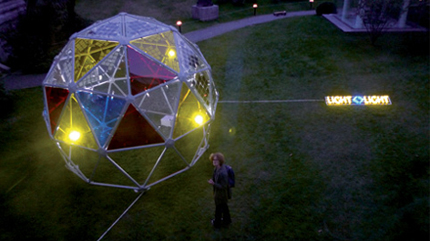LIGHT FROM LIGHT: ART IN THE LIBRARY
| September 1, 2011 | Post In LEAP 10

A LIBRARY IS a place full of curiosities, both concrete and abstract. It provides storage for knowledge, yet it is also a site where different groups of people meet. In the urban life of Beijing, the symbolic significance of libraries has long surpassed their actual function. The National Library of China, located in the university district on the capital’s west side, has long presented itself as the old-school, state-run work unit where only an appropriate certification, government rank or degree could grant its holder access to the various reading rooms. Throughout the building, signs admonishing visitors that entry was reserved for “Citizens of the People’s Republic of China who hold technical titles of intermediate status or above, administrative posts of department level or above, or degrees at the graduate level or above” were ubiquitous. From the cumbersome process for obtaining a borrower’s card to the building itself, completed in 1987, the National Library bore indelible traces of the previous century. Indeed, the antiquated institution’s winding corridors and somewhat depressive atmosphere are not without their aesthetic, but it is as if its internal clock stopped at some date in the 1990s, freezing it in a condition separate from the city’s rapidly advancing tempo.
Interestingly, at the time in 1975 when Premier Zhou Enlai approved the site near Purple Bamboo Park for building the library, land was already being set aside for “Phase Two” constructions that would serve “the next century’s development.” And so in 2008, at perhaps the most carnivalesque time since this city entered the new millennium, the National Library’s newest building opened its doors. The new building’s design is more in line with modern perspectives and needs. Windows and significant use of glassware bring plenty of sunlight indoors. At the building’s center is a great central hall, around which unenclosed reading areas occupy all levels from basement to the third floor, creating the impression of an open courtyard. From the wrap-around veranda, visitors can see to the building’s very base. Aside from an architectural update, the National Library also removed the certification-based restrictions and simplified its procedures for borrowing and returning materials. Wireless internet covers the entire campus. Online, there is now a platform for downloading electronic books. It looks like the National Library is striding into a new era.

In April of this year, the exhibition “Light from Light,” organized by Multimedia Art Asia Pacific (MAAP), welcomed visitors to National Library. MAAP has been engaged in contemporary media art in Australia and the Asia Pacific region since 1988. Director of MAAP Kim Machan said of this project, “The concept of time is very different when one is in a library, where it is slow and quiet. Compared to an art gallery or a museum, people spend a lot more time here. So how they approach the artworks is also different.” These are an exhibition organizer’s considerations. Viewed from another angle, it is nothing new to bring artworks into public space. But when the exhibition occurs at the National Library, things become interesting. Do these artworks indicate that from now on the Complete Library in Four Branches of Literature— that vast collection of books assembled at the direction of Emperor Qianlong (r. 1735-1799)— can peacefully coexist with new media art? Yet Kim Machan and her team encountered more communication problems at the National Library than at the other stops of this traveling exhibition, in Shanghai and Hangzhou. “Light from Light” is part of The Year of Australian Culture in China, 2010-2011. At the end of 2010, the exhibition opened simultaneously at the State Library of Queensland in Brisbane and the Shanghai Library, like two copies of a book being perused at two distant locations. After its stop at the National Library, “Light from Light” opened at Hangzhou Library in July 2011. Numerous Chinese and Australian artists contributed with neon art objects, light sculptures and other works new media. The Chinese artists participating in the exhibit include Zhang Peili, Wang Gongxin, Lin Tianmiao, Wang Peng, and Pak Sheung Chuen from Hong Kong.
According to MAAP’s materials, “The exhibition reflects on the multi-dimensionality of light: it is a fundamental life- sustaining energy source, a powerful physical property, a trope of the dynamic modern city, as well as a metaphor for both rational thought and spirituality.” The title “Light from Light” comes from the name of the solar-powered, outdoor sculpture installation by Australian artists Janet Burchill and Jennifer McCamley, “in a nod to both the city of the future and the utopian experiments of the past.” Overall the exhibition is welcoming and skillfully crafted. The works of art are not conspicuously displayed, but instead “hidden” in different locations throughout the Library. A piece by Zhang Peili consisting of phrases translated into different languages using Google is installed at the top of a series of bookshelves. Lin Tianmiao’s work is in a private reading room placed just off a pathway. As for Grant Stevens’ Turtle Twilight, it is found on screens near the reference desk. Without a guided tour, it took this visitor a while to locate and view all of the artworks, but his is precisely the effect that Kim Machan wanted to realize. After all, a library is the sort of place to which one should keep returning. Translated from Chinese: Liu Jiajing


